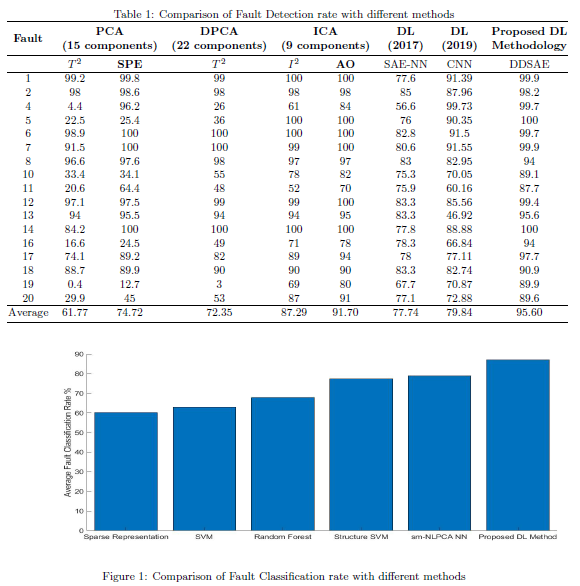The fourth industrial revolution also known as 'Industry 4.0' and Big Data revelations has enabled the manufacturing industries to boost its performance in terms of operation, economic and safety. In order to meet high expectations of quality, efficiency and reliability of the product, a process monitoring system is needed. The two important aspects of Statistical Process Monitoring (SPM) are fault detection and diagnosis (FDD). Safe operation of process plants can be ensured by determining if the current state of the process is normal or abnormal. This problem is known as "Fault Detection". Following the detection of abnormality in the process, the next step is to classify the fault and diagnose its causes, also known as "Fault Diagnosis/ Classification". Noisy and high dimensional recorded process inputs greatly hinders the FDD mechanism in process plants. Previously, traditional linear PCA and its variants [1,2] based methods have been extensively used for fault detection and prognosis. However, the inherent non-linearity in the process poses challenges for these methods. To this end, deep learning methods have shown considerable improvement over traditional methods [5,6]. Deep learning methods can be broadly classified into two categories: 1) Unsupervised Learning; 2) Supervised Learning. In this work, we use a supervised approach on a benchmark Tennessee Eastman Process (TEP) and show the improvement over both PCA-PLS based methods, unsupervised learning and previously used supervised learning based methods. This work is motivated by the fact that deep learning algorithms require generally large amounts of data for proper training and thus, their accuracy may be compromised when using relatively small datasets (bottleneck for many industries such as pharmaceutical industries etc.). Therefore, there is a large incentive to increase the accuracy of deep learning based FDD models without increasing the amount of data for training. Towards this goal the concept of explainability of Neural Networks (NNs) is exploited to improve the accuracy of the FDD without increasing the amount of data. In this study, the explainability of the effect of the inputs on the output classes is quantified by relevances interpreted using Layer-wise Relevance Propagation (LRP) and the irrelevant input variablesâ for the supervised classification problem are discarded thus enhancing both fault detection and fault diagnosis accuracies [3,4]. This relevance based procedure greatly reduces the number of tuning parameters in the network and also provide physical insights for the classification problem at hand. Lastly, we use Dynamic Deep Supervised Autoencoder (DDSAE) NNs which improves the classification ability compared to traditionally used SAE (Stacked Autoencoder) NNs. The efficacy of the proposed method over different methods for both Fault Detection and Diagnosis are shown in Table \ref{comparison-detection} and Figure \ref{comparison} respectively.
The proposed deep learning based detection method is compared with linear Principal Component Analysis (PCA), Dynamic Principal Component Analysis (DPCA) , Independent Component Analysis (ICA) and with two other recently reported methods that use Deep Learning models (architecture used: Sparse Stacked Autoencoder NNs (SAE-NN) and Convolutional NN (CNN)) for the same data set. For the Fault Diagnosis problem, the proposed method is compared with Support Vector Machines (SVM), Random Forest, Structure SVM, and sm-NLPCA (architecture used: Stacked Autoencoder). It is observed that the proposed relevance based method significantly increases the average fault detection accuracy over other methods.
References:
[1] Xiaofeng Yuan, Jiao Zhou, Yalin Wang, and Chunhua Yang. Multi-similarity measurement driven ensemble just-in-time learning for soft sensing of industrial processes.Journal of Chemometrics, 32(9):e3040, 2018.
[2] Barry M Wise, NL Ricker, DF Veltkamp, and Bruce R Kowalski. A theoretical basis for the use of principal component models for monitoring multivariate processes.Process control and quality, 1(1):41â51, 1990.
[3] Piyush Agarwal and Hector Budman. Classification of profit-based operating regions for the tennessee eastman process using deep learning methods.IFAC-PapersOnLine, 52(1):556â561, 2019.
[4] Piyush Agarwal, Melih Tamer, M Hossein Sahraei, and Hector Budman. Deep learning for classification of profit-based operating regions in industrial processes.Industrial & Engineering Chemistry Research, 2019.
[5] Gavneet Singh Chadha and Andreas Schwung. Comparison of deep neural network architectures for faultdetection in tennessee eastman process. In2017 22nd IEEE International Conference on Emerging Technologies and Factory Automation (ETFA), pages 1â8. IEEE, 2017.
[6] Seongmin Heo and Jay H Lee. Statistical process monitoring of the tennessee eastman process using parallel autoassociative neural networks and a large dataset. Processes, 7(7):411, 2019.

